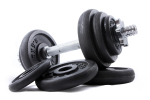|
2006/12/05, 09:53 PM
I don't know why I didn't post this on here a long time ago, but reviewing some of my articles I have saved on my laptop, here is another beneficial one of being proactive, instead of reactive. Good Luck!
-----------------------------------------------
How long do running shoes last?
Running in old or worn out shoes can lead to an increase in running injuries. Over time running shoes lose stability and shock absorption capacity. When this happens the stress to the feet and legs increases dramatically. Over time such added stress can lead to an overuse injury. A simple prevention strategy includes replacing running shoes when they wear out.
The midsole layer of a shoe provides the cushioning and stability. This area usually wears out before the outsole shows major signs of wear. When a midsole wears out the shoe looses functional stability. It is this loss of stability and cushioning that leads to increased stress and increased injury risk.
It is recommended that you replace running shoes between 350-550 miles depending on your running style, body weight, and the surface on which you run. Lighter runners can get closer to the upper end of the recommendation while heavier runners are harder on shoes and should consider replacement shoes closer to 350 miles.
Running Shoe Replacement Tips
Track your mileage. After 350-550 miles it's time for a new pair. For runners who log 25 miles per week replace your shoes every three to four months.
You can check for signs of wear on the sole by placing your old shoes on a table and looking at them from behind. If the soles are worn and leaning to one side, the midsole cushioning is probably worn as well.
Spotting Midsole Wear
A shoe's midsole cushioning may be worn out long before the tread shows signs of wear. Because the bottom and tread of the shoe may look fine, identifying when the cushioning is shot isn't easy to do. Here are some tips for identifying midsole wear:
First, pay attention to how you feel. As your shoes begin to give out, you may begin to get some aches or pains in your bones and joints. You may also notice slight muscle fatigue, new tightness, or possible shin splints.
Look for creasing of the midsole material in areas of high load (under the heel or the ball of the foot). A worn out midsole will have wrinkles and creases there.
Try to twist the shoe. A worn out midsole will allow the shoe to twist more easily than a new shoe.
Try on a new pair of the model that you are currently wearing. Compare this to your current shoes. If the cushioning in your shoes feels dead in comparison, it probably is.
Consider Rotating Shoes
If you run frequently it's a good idea to have more than one pair of shoes. Think about buying two pair at a time (or buying a second pair about midway through the life of your first). Add the new pair in to your shoe rotation when your "old" shoes have about 200 miles on them. If you use two pairs of shoes you should still track mileage per shoe, and replace each after it has 350-550 miles on it.
--------------
Bettia
To be motivated, motivate others!
|



